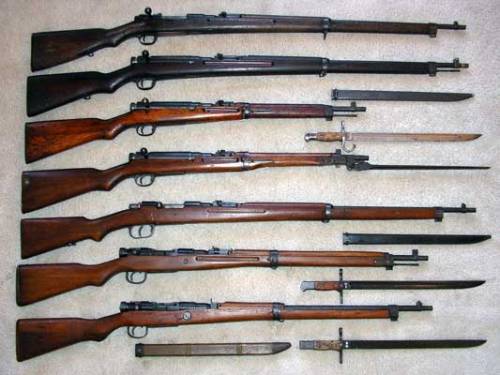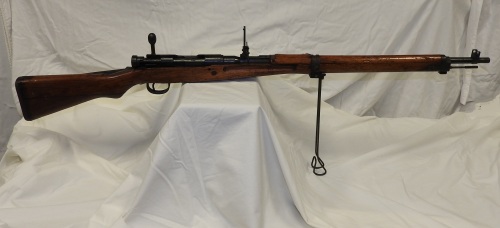Midway Village Museum has a permanent collection of nearly 150,000 artifacts. Within the walls of the museum are untold stories of amazing relics. In honor of our upcoming WWII Days event, we’d like to share a piece of history with our readers. In our weaponry collection, we have a Japanese Arisaka Type 99 bolt action infantry rifle from WWII, brought back by Everett Charles Sarver. Before continuing with this story, let’s get some more background on Mr. Sarver and why this particular weapon is one of the best bolt action rifles to have been produced.
Everett Charles “Son” Sarver was born on April 24, 1916 to Everett Alexander and Lauretta Sarver. He and his father, Everett Alexander, began a livestock hauling business that evolved from Everett Alexander’s garbage hauling job from Camp Grant. E.A. Sarver & Son began circa 1934, and by 1941, E.C. had taken over the business; it became E.C. Sarver Livestock Trucking. E.C. Sarver owned and operated this trucking company before he entered the Navy.
He was drafted into the Navy in 1944 during WWII and served until 1946 in the Pacific on the U.S.S. Minotaur. Everett was the U.S.S. Minotaur’s mailman and the Captain’s Talker (he relayed orders via an intercom system to stations beyond the bridge). As mailman, he would go in a small boat from ship to shore to pick up mail and “other illicit things.” It is believed that this is how he acquired an Arisaka Type 99 bolt action rifle and bayonet.
The Type 99 rifle was created as a result of Imperial Japan’s fast track to modernization, called the Meiji Restoration (1868-1912). During that time, Japan was quickly assimilating Western technologies and improving upon them in order to become a colonial power. Before WWII, Japan had already started taking over territories in China and had defeated Russia to claim land in Manchuria and Korea. As Japan’s power grew, their military spread into other parts of Asia, leading to the Second Japanese-Russo War and later, WWII.
The Type 99 rifle and its predecessors, the Type 30 and Type 38, were created by Nariakira Arisaka during these conflicts. The type 99 came in four versions: the Type 99 short rifle (a standard infantry rifle), the Type 99 long rifle (limited production), a Takedown Type 2 Paratrooper rifle, and the Type 99 sniper rifle. The standard infantry rifle had a monopod as well as an anti-aircraft rear sight meant to take down low flying lightly armored bombers.

Arisaka rifle evolution (from top to bottom): 1. Type 30 2. Type 38 3. Type 38 carbine 4. Type 44 carbine 5. Type “I” model 6. Type 99 (earlier model) 7. Type 99 (later model)
The Type 99 rifle was basically an improved version of Type 38, but with the increased firepower of a 7.7mm cartridge (the 38 used a 6.5mm cartridge). The 99 could chamber a 5 round stripper clip. It had a quick-release bolt and a safety measure built in so that the spent cartridges would fly away from the soldier. It also had a chrome lined bore for easier cleaning. Although it had the heavier firepower, it also had a strong kickback due to its lighter stock. The Type 99 came with its own bayonet in the form of a long slender blade, often grooved to reduce weight. The Type 99 was a strong and solid weapon and one of the best bolt action rifles of its time.
The Type 99 was produced by 8 factories over the course of its service. These included Nagoya and Kokura in Japan, the Jinsen Arsenal in Korea, and Hoten (Mukden) in Manchuria. There were also subcontractors throughout mainland Japan producing these rifles. The rifles were produced in series of 100,000 with its numbering being 0 to 99,000 before the count would start over. The Type 99 rifle was only manufactured from 1939 to 1945. As the war progressed and pressure increased for Japan to manufacture more weaponry, the quality of these weapons decreased. At the end of WWII a batch of “last ditch” rifles were produced and they are known for their crude and simple design.
Most of the weaponry collected from Japan after WWII had any significant symbols/insignia removed or defaced by the Japanese before they were handed over. The Type 99 rifle in particular had its Imperial Chrysanthemum blossom ‘mon’ (a Japanese emblem used to identify an individual or family) removed before being turned over. One theory behind this act is that it would have been disrespectful to the Emperor if his ‘mon’ was allowed to remain upon a weapon handed over the enemy. Any rifles with the ‘mon’ still intact indicate that they were taken before the surrender by Chinese, British, or American soldiers.

Arisaka Type 99 Bolt Action Rifle from Midway Village Museum’s permanent collection
Above is an image of the Type 99 bolt action infantry rifle in our collection. Its arsenal mark and serial number, 3976, indicate that it was part of the 31st series of rifles manufactured by Toyo Kogyo under contract to Kokura Arsenal. It was most likely manufactured during 1942-1943. The story of Mr. Sarver bringing this rifle back with him during WWII is supported by the Chrysanthemum ‘mon’ still being intact on this rifle. If the rifle had been handed over after the war, the ‘mon’ would no longer be present or fully intact. The writing below the ‘mon’ is ‘kyu-kyu-shiku’ which roughly translates to Type 99, meaning that the rifle is a Type 99. Our rifle has a flip up anti-aircraft rear sight, monopod, and is made from better quality materials than the ‘last ditch’ rifles at the end of the war.
The bayonet that came with our rifle has a hook guard and a serial number of 2271908, which suggests it was made in the 1910s and would have been issued originally with an Arisaka Type 38 rifle. Our rifle measures 44in in length from the butt to the barrel and is roughly eight pounds.

Type 30 bayonet & scabbard from WWI that came with the Arisaka Type 99 rifle
Once Everett Charles Sarver returned home, he ran his trucking business until 1969. He had married Ruth Irene Wickens in 1941 and together they had three children: Suzanne Mary, Charles “Chuck” “Charlie” Sarver, Jr., and Linda Kay. Everett Charles Sarver passed away on October 24, 1991.
-Post written by Tiffany Arnold, Assistant Curator at Midway Village Museum





